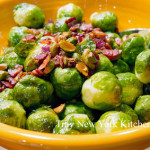Brussels sprouts have a pronounced and sweet nutty flavor, quite unlike cabbage, although the two are closely related. They are traditionally served at Thanksgiving and Christmas and have an affinity with certain nuts, such as almonds, pistachios, and chestnuts. Brussels sprouts taste great with onions, and ginger, or with nuts.
Brussels sprouts should be small and hard with tightly wrapped leaves. Avoid any that are turning yellow or have loose leaves. They will keep in a cool place or in the salad drawer of a refrigerator for several days.
When preparing and cooking Brussels sprouts trim away the base of the stalk and remove the outer leaves. If the sprouts are large, cut them in half or quarters, or slice thinly for stir-frying. Cook very briefly in small amounts of fast-boiling water. Alternatively, stir-fry with onions and ginger, in a little oil and butter.
“Work With What You Got!”
© Victoria Hart Glavin Tiny New York Kitchen © 2016 All Rights Reserved
A sandwich doesn’t have to be full of fat and calories. Replace high-fat mayonnaise with one of the reduced-fat varieties. You may want to stir in some chopped fresh herbs into reduced-fat mayonnaise for a flavor boost. You may also want to hold the mayo and spread your bread with mustard, as mustard is naturally low fat. You may also want to try a spread of non-fat yogurt mixed with a bit of mustard. Chutney, delicious by itself or when blended with mayonnaise or mustard, adds a sweet and spicy dimension to a sandwich.
Many lunch meats are high in sodium and calories. Look for alternatives such as grilled vegetables or skinless chicken breast, roasted turkey breast, or shrimp in a low-fat dressing. Another good alternative is water-packed tuna.
Cheese is a high-fat sandwich ingredient that should be eaten in moderation. Choose lighter cheeses such as Swiss or low-fat cheese.
Rather than ordering your sandwich at the deli counter, take a stroll by the salad bar. There are many candidates for a great sandwich just waiting to be piled onto bread (or into a pita) and drizzled with low-fat dressing.
A few healthy choice ingredients are: artichoke hearts, roasted peppers, pepperoncini, sprouts, shredded carrots, asparagus, sliced tomatoes, and tofu.
"Work With What You Got!"
© Victoria Hart Glavin Tiny New York Kitchen









